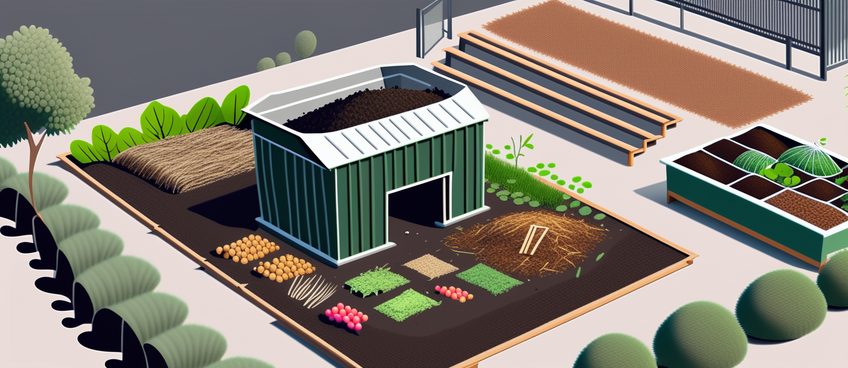Composting Methods: The act of composting, as ancient as it may be, represents one of humanity’s first steps towards sustainable living. This ingenious biological process, through the decomposition of organic waste, replenishes the soil with a trove of nutrients. In this era of ecological challenges, composting has never been more significant. However, not all composting methods are created equal. This article aims to dissect and delve into the intricacies of various composting methods, assessing their efficiency and suitability in different scenarios.
Traditional Composting Methods
Backyard Composting
Backyard composting is a rudimentary but efficient method of waste management. An accessible process, it offers numerous benefits, such as the creation of nutrient-rich soil, the reduction of waste sent to landfills, and the conservation of water by improving soil structure. Essential elements required for backyard composting include organic waste, water, and air.
In a step-by-step journey to backyard composting, one begins by selecting a dry, shaded spot near a water source for the compost pile or bin. Layering green and brown materials is recommended, ensuring to moisten dry materials as they are added. Then, the addition of grass clippings or green leaves on top completes the setup. Regular turning or mixing enhances the decomposition process.
Vermicomposting
Vermicomposting, a term that likely elicits a wriggle of interest, refers to the use of earthworms in composting. This method boasts benefits like faster composting time and a product that’s richer in nutrients compared to traditional compost.
Selecting the right species of wormusually red wigglers (Eisenia foetida)is crucial for efficient vermicomposting. Setting up the system requires a worm bin, bedding such as shredded paper, and, of course, kitchen scraps. With proper maintenance, which includes feeding the worms and maintaining the moisture and pH levels, the compost can be harvested in two to three months.
Aerobic Composting Methods
Open Pile Composting
Open pile composting, known for its simplicity, is a method involving the accumulation of organic matter in an open pile. This composting method is influenced by several factors, such as size and location of the pile, and the materials used. While its open nature provides easy access to oxygen, it can also be a haven for pests and susceptible to weather fluctuations.
Best practices for open pile composting involve balancing green and brown materials, regular turning to introduce oxygen, and maintaining appropriate moisture levels.
Compost Bins and Tumblers
Compost bins and tumblers, often seen as more sophisticated alternatives to open piles, come in different designs and sizes. While they offer advantages such as faster decomposition, protection from pests, and ease of turning, they can be pricier and may require more effort to balance the compost materials.
To optimize composting efficiency with bins and tumblers, regular turning and aeration are key, as well as maintaining the right balance of composting materials.
Anaerobic Composting Methods
Bokashi Composting
Originating from Japan, bokashi composting harnesses the power of beneficial microorganisms. Unlike traditional composting methods, bokashi composting works well with kitchen scraps, including meat and dairy products.
The process of bokashi composting involves layering kitchen waste with a special bran that’s inoculated with these microorganisms, in an airtight container. After two weeks, the pre-compost can be buried in the garden soil to fully decompose.
Compost Tea Brewing
Compost tea, a potent, nutrient-rich solution made from compost, has been lauded for its benefits to plant health. The brewing process, which involves soaking compost in water and adding aeration, can be performed using simple equipment.
The resulting compost tea can be used as a foliar spray or soil drench, serving as a natural disease suppressant and enhancing plant growth.
Industrial Composting Methods
In-Vessel Composting
In-vessel composting, as the name implies, involves composting organic material within a contained vessel. This method, often used industrially, allows for greater control over environmental conditions, leading to faster decomposition rates.
These systems come in various designs, including rotating drums, concrete-lined trenches, and vertical silos, each with their unique advantages.
Windrow Composting
Windrow composting, another large-scale method, involves piling organic material into long, narrow windrows that are turned regularly. Although labor-intensive, this method proves effective for managing large volumes of waste.
Managing windrow composting effectively involves careful monitoring of temperature, moisture, and oxygen levels.
Factors Affecting Composting Efficiency
Carbon-to-Nitrogen (C:N) Ratio
The C:N ratio, a critical aspect of composting, significantly affects the speed and quality of the compost. The optimal C:N ratio generally ranges between 25:1 and 30:1. Adjusting this ratio can be achieved by mixing different materials, such as dried leaves (high carbon) and vegetable scraps (high nitrogen).
Moisture Levels
Moisture plays a pivotal role in composting, as it influences the activity of microorganisms involved in the process. Achieving and maintaining an optimal moisture level typically compared to the dampness of a wrung-out sponge ensures the composting process stays efficient.
Temperature Management
Temperature is another crucial factor in composting, as it impacts the decomposition rate and the elimination of pathogens. Maintaining a temperature between 55 and 65 degrees Celsius typically yields the best results. This is the realm of thermophilic composting, a method known for its speed and high heat, which helps kill weed seeds and disease-causing organisms.
Comparing Composting Efficiency
When comparing composting methods, several factors come into focus. These include the composting speed and duration, nutrient content and quality of the compost, weed seed and pathogen suppression capabilities, odor control and pest management, as well as overall environmental impact and sustainability.
Case Studies: Real-world Examples
Case Study 1: An urban environment study compared backyard composting and vermicomposting, revealing that while both were viable options, vermicomposting was faster and produced richer compost, making it ideal for apartment dwellers with limited space.
Case Study 2: A study on industrial-scale composting compared in-vessel composting and windrow composting. The in-vessel method proved more efficient, albeit more costly. Windrow composting, however, offered an economical solution for large-scale operations with enough space.
Case Study 3: An assessment of bokashi composting in small-scale gardening demonstrated its effectiveness, particularly in handling kitchen waste that couldn’t be composted traditionally, thereby significantly reducing waste volume.
Best Practices for Effective Composting
Effective composting begins with selecting the appropriate method for your needs, preparing and managing composting materials correctly, and regularly monitoring the compost pile. Understanding common composting issues and how to troubleshoot them is also crucial. Lastly, harvesting and using compost effectively will ensure your gardening efforts bear the most fruitful results.
Conclusion of Efficiency of Different Composting Methods
Composting is a dynamic interplay of variables, each impacting the others in the larger quest for sustainability. From the most basic backyard setup to the highly controlled in-vessel systems, every composting method serves a unique purpose and has its strengths and weaknesses. As a consumer, understanding these methods and selecting the most suitable one for your specific needs is paramount. Embracing composting not only contributes to a more sustainable lifestyle but also serves as a testament to our commitment to preserving our planet.
FAQs About Efficiency of Different Composting Methods
Q1 What is the ideal composting C:N ratio?
Ans: Composting’s ideal C:N ratio is 25:130:1. This balance gives decomposer microorganisms the right nutrients.
Q2 Can meat and dairy be composted traditionally?
Ans: Meat and dairy can be composted, but backyard and open pile composting are not recommended. Decomposing materials attract pests and smell bad. Bokashi composting can handle these wastes.
Q3 Does temperature impact composting?
Ans: Composting relies on temperature to decompose and kill pathogens. Composting is best at 5565 degrees Celsius. High temperatures (within these limits) kill weed seeds and disease-causing organisms, making compost safer.
Q4 How does compost tea help?
Ans: Compost tea helps plants and soil. Its concentrated nutrients suppress disease and boost plant growth. As a foliar spray, it deters pests and diseases.
Q5 What distinguishes aerobic and anaerobic composting?
Ans: Oxygen determines aerobic versus anaerobic composting. Microorganisms break down organic matter in oxygen-rich aerobic composting. This method decomposes material faster and less odorously. However, anaerobic composting takes longer and stinks more. Anaerobic composting is bokashi.
Our Reader’s Queries
What is most effective method to compost?
To achieve success in composting, it’s important to chop larger materials before adding them to the mix. Additionally, it’s recommended to mix brown materials with green materials for optimal results. To maintain the right level of moisture, aim for a dampness similar to that of a wrung out sponge. By following these simple tips, you can ensure that your composting efforts are effective and efficient.
What are 3 best practices for composting?
Simply place organic matter in a container and let it be. This approach offers the benefit of not requiring any turning, drilling, or digging. The compost can naturally heat up and decompose without any intervention, making it a hassle-free and low-maintenance option. It’s the perfect “set it and forget it” method for those who want to simplify their composting process.
What is the laziest way to compost?
Composting comes in three types: aerobic, vermicompost, and anaerobic. Each method has its own advantages and disadvantages, so it’s important to choose the one that fits your materials, space, and climate. As a composter, you have the freedom to select the best method for your needs.



